10 Ways to Save Energy, Waste, and Money With a More Sustainable Home
By Jon Gorey
With much of the country housebound for the last several months in an effort to slow the spread of the novel coronavirus, our homes have been working harder than ever. Our air conditioners are running during the hottest hours of the afternoon, when we might ordinarily be in a frosty office building. We've been prepping and eating every meal at home—demanding much more from our stoves, microwaves, coffeemakers, and dishwashers.
In fact, home electricity use surged 22% in April compared to last year, according to Sense, which makes home energy monitors and other smart home technology. Columbia University researchers likewise found that April energy use in New York City apartment buildings increased 23% during daytime work hours, shifting the burden of utility costs from commercial buildings to individuals. With the average electricity bill for U.S. households running about $118 a month, that translates to an extra $25 a month—at a time when millions of people are out of work or furloughed and already struggling with their bills.
And it's a trend that's unlikely to end anytime soon. While states are starting to ease restrictions, a lot of people fortunate enough to still have a job will be working from home for the foreseeable future. At Earthwatch, we've been stuck at home, too, but that hasn't changed our commitment to environmental conservation. So we thought we'd share some ways to save energy and money at home with a more sustainable and less-waste lifestyle.
Save Energy, Money, and the Environment
 1. Ease up on the AC.
1. Ease up on the AC.
Air conditioning accounts for about 17% of the average household's annual electric use, and obviously far more during the summer months. If you ordinarily spend your summer weekdays in an air-conditioned workplace, your home energy use may spike even higher in coming weeks.
But take it from someone who's been working from home for over five years now: You don't need to keep your house as cold as an office building. You're working remotely—you can wear shorts and flip flops! The U.S. Energy Department recommends setting your AC to 78 degrees Fahrenheit when you're home, and 85 when you're out, to shave up to 10% off your cooling bill.
In our house, we try to cool things down the old fashioned way. As long as it gets down to the 70s or lower at night, we open a bunch of windows to let that cool night air in (or suck it in with a fan), then close them in the morning and draw the curtains shut on the east and south sides of the house—trapping the cool air indoors and keeping the sun from heating things up too fast. Even on 90-degree days, we can usually make it until about 4pm before caving and switching on the AC.
Also remember that your cabinets and couches don't really care if they're cool—the main goal is to keep yourself and your family comfortable, not your furniture. So if you spend most of the day holed up in your home office, you don't need to cool your entire 2,000-square-foot house to 75 degrees, just that one room. A simple fan can also augment your air conditioner, allowing you to keep the thermostat a few degrees warmer without sacrificing comfort.
Finally, help your AC help you. Check the air filters and clean or replace them as needed so the unit isn't struggling to circulate air. Find and seal leaks in the air ducts or around windows and doors so you're not losing as much of that precious cold air. Try to grill in warm weather instead of heating up the kitchen by cooking indoors, and use your stove and bathroom exhaust fans to get rid of hot, sticky air after dinner prep or a shower—just make sure to turn these fans off 15 to 20 minutes after you're done, so you're not sending chilled air out the roof.
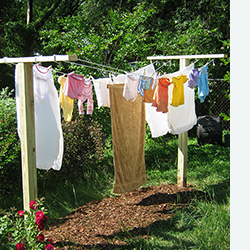 2. Hang dry laundry.
2. Hang dry laundry.
There may be one area where you're actually conserving resources during this pandemic: laundry. If you find yourself wearing the same pair of jeans all week when you'd normally be churning through new outfits daily for school or work, maybe you've cut down a load or two per week. Either way, electric dryers comprise 5% of the typical household's electricity usage, so every time you can hang dry your laundry on an outdoor clothesline or indoor drying rack, you'll save energy, save money, and reduce your carbon footprint.
 3. Wash clothes in cold water, and install efficient shower heads.
3. Wash clothes in cold water, and install efficient shower heads.
Before you dry them, try washing your clothes in cold water as a default if they're not filthy. Heating water takes a lot of energy, accounting for about 14% of the average home electric bill.
Installing a well-designed, low-flow shower head can help you save energy, too. The best ones (look for the EPA's WaterSense certification) are independently tested to ensure they maintain forceful water pressure while cutting your hot water usage dramatically, saving an average of 330 kilowatt hours of electricity per year, according to the EPA. In New England or California, where electric rates average about 22 cents per kwh, that amounts to a savings of $72 a year.
While we're talking about water usage, did you know that Americans pour almost a third of our treated drinking water into the ground to irrigate our lawns? A rain barrel can capture runoff from your roof—rainwater that might otherwise overwhelm storm drains—to provide a free source of irrigation later on. You might also consider planting a rain garden or even replacing a portion of your lawn with native perennials that, once established, won't need any more water than what nature provides (and can support local pollinators like butterflies and honey bees).
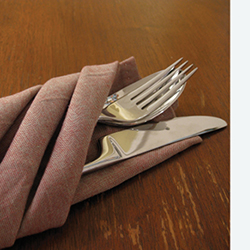 4. Use cloth napkins and rags instead of paper towels.
4. Use cloth napkins and rags instead of paper towels.
With paper products hard to come by during the pandemic, some families are learning what others have long known to be true: It's way cheaper to wash and reuse a set of cloth napkins or dish towels than to churn through roll after roll of paper towels every month. Cut up old, ripped t-shirts for grosser jobs, and if cotton isn't a quick-enough picker-upper for your household, try a super-absorbent and biodegradable Swedish-style cellulose sponge cloth that can be washed and reused dozens of times.
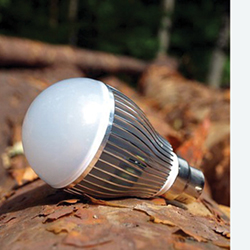 5. Gradually switch to LED light bulbs.
5. Gradually switch to LED light bulbs.
If you haven't already, buy a pack of LED light bulbs so you can gradually replace any old incandescent bulbs as they burn out. LED bulbs are about six times more efficient and generally last much longer, too (and unlike the CFL bulbs of yore, they don't need to "warm up" to reach full brightness).
Assuming your lights are on for an average of four hours a day, replacing just four 60-watt incandescent bulbs with their LED equivalents would save about 300 kwh of energy annually—about $66 a year in New England or California. (For what it's worth, I recommend getting soft or warm white bulbs, because the daylight and cool white tones feel more like a sterile hospital or department store.)
 6. Go reusable.
6. Go reusable.
Our eight-year-old loves yogurt squeeze tubes and those abominable sugar-and-food-coloring ice pops. While the latter are pretty cheap, the yogurt squeezies are not—and both stress me out because of all the plastic waste they generate. That's why I now swear by silicon freeze pop molds, which allow to you make your own ice pops out of smoothies, juice, yogurt, or whatever else you want to throw in there. Then you just wash them on the top rack of the dishwasher and repeat. They've been a huge money- and waste-saver in our house, and allow us to ensure our daughter is having healthier frozen treats. (Pro tip: If you've got more ripe bananas than you'll be able to eat, peel and freeze them before they go bad to save for future smoothies.)
We've also eliminated the need to buy plastic Zip-Loc bags by using silicon sandwich and snack bags for school lunches, and repurposing old salsa jars and Tupperware for storing things like carrot sticks in the fridge.
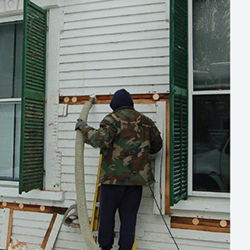 7. Add insulation.
7. Add insulation.
Many states offer financial incentives to retrofit drafty homes with blown-in or attic insulation, especially in areas with cold winters and lots of old houses. Sometimes these incentives are almost too good to pass up. For example, Massachusetts will generally pay for 75% of the cost of weatherization and insulation improvements through its MassSave program, and right now homeowners can receive 100% reimbursement (up to $15,000) as long as they schedule a free virtual energy assessment by May 31.
Our house was built in 1920 and could feel downright breezy on a cold windy night, so we took advantage of the MassSave insulation incentive a couple of years ago. It was kind of a hassle, but we definitely noticed a difference afterward, both in personal comfort and our heating and cooling bills—ended up saving about $400 a year on heating alone. If your state or community offers a similar program, it's a great way to save energy for years to come.
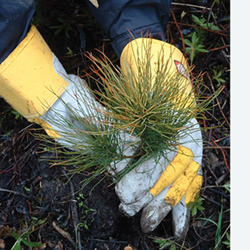 8. Plant some trees—in the right spots.
8. Plant some trees—in the right spots.
This one will take some time to yield results, but thoughtfully positioned trees can lower your home's energy needs by up to 25% a year. (Not to mention their carbon-sinking super powers.)
For example, planting deciduous shade trees on the south and west sides of your home can shade your windows and walls from the hot summer sun and lower the air temperature around your home, easing the load on your air conditioner. And once their leaves fall, warming winter sunlight can still get through—but dense evergreen trees or shrubs planted on the north side of your lot can block biting winter winds and reduce heating costs.
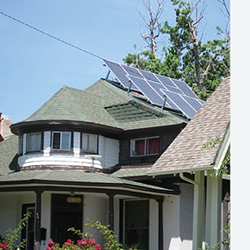 9. Consider going solar.
9. Consider going solar.
Whether you save money by installing rooftop solar panels will depend on where you live—in every sense of the phrase. In areas where electricity is more expensive, solar power becomes a better bargain, and some states or communities offer tax rebates and other financial incentives that further sweeten the deal. Meanwhile, the physical location and orientation of your home matters, too: Going solar makes the most sense if your roof gets a lot of unobstructed sunlight.
But chances are, if a good portion of your roof faces south-ish, you could reduce or eliminate your electric bill (and your carbon footprint) by installing solar panels. That comes with a hefty upfront cost—the average-sized installation costs about $11,400 to $14,800, after federal tax credits (26% in 2020, 22% in 2021, and 10% thereafter). But you can use a home equity loan to pay for it; some states, such as Massachusetts, even offer low-interest solar loans.
We ran the numbers on our house and decided solar was very much worth it, and took out a 10-year solar loan to pay for the installation, basically swapping our electric bill for a similar but fixed loan payment. And then, after Year 10, we should get another 10 to 20 years of completely free renewable electricity. A site like EnergySage.com can help you crunch the numbers for your own home and solicit quotes from reputable solar installers.
 10. Grow some of your own herbs, spices, or vegetables.
10. Grow some of your own herbs, spices, or vegetables.
Gardening is having a moment, with everyone stuck at home this spring amidst food shortages and supply chain breakdowns. You don't need a big yard or a green thumb to grow a bit of your own food, and given the cost of good fresh produce, it can save you some money, too.
Tomatoes, blueberries, and thornless blackberries are easy and popular choices to grow at home, even in containers on a sunny porch if you don't have a sun-soaked acre to work with. Shadier spots (like our backyard) are perfect for perennial chives, which come back effortlessly year after year and can be harvested all season long. (I sent our daughter out just today to cut some chives for this German potato salad recipe!)
Even in a small apartment, you can grow common herbs like basil, mint, or rosemary on a windowsill and never again have to fork over three bucks for a couple of sprigs that wilt in the fridge before you get to use them.
Affiliate disclosure: As a participant in the Amazon Associates program, Earthwatch may earn a small commission from qualifying purchases made through links in this post.
Sign up for the Earthwatch Newsletter
Be the first to know about new expeditions, stories from the field, and exciting Earthwatch news.